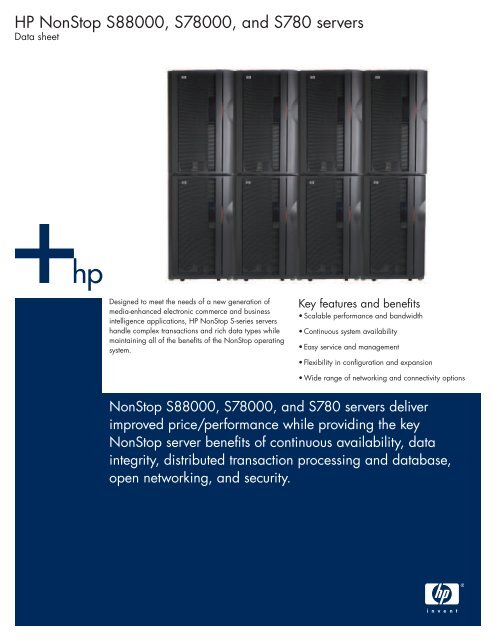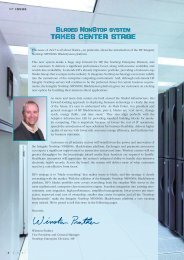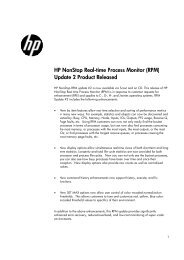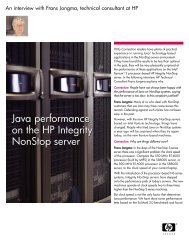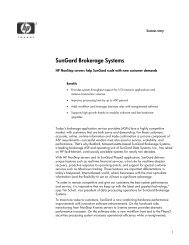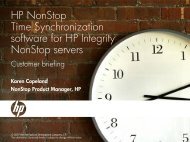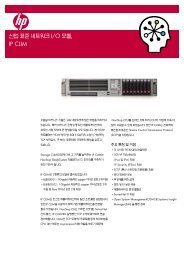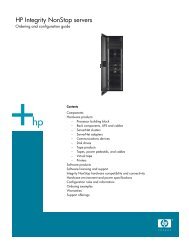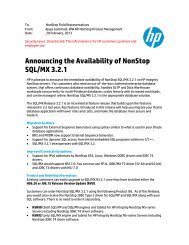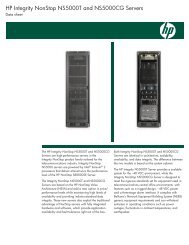HP NonStop Modular I/O subsystem data sheet - PDF (August 2004)
HP NonStop Modular I/O subsystem data sheet - PDF (August 2004)
HP NonStop Modular I/O subsystem data sheet - PDF (August 2004)
You also want an ePaper? Increase the reach of your titles
YUMPU automatically turns print PDFs into web optimized ePapers that Google loves.
<strong>HP</strong> <strong>NonStop</strong> S88000, S78000, and S780 servers<br />
Data <strong>sheet</strong><br />
Designed to meet the needs of a new generation of<br />
media-enhanced electronic commerce and business<br />
intelligence applications, <strong>HP</strong> <strong>NonStop</strong> S-series servers<br />
handle complex transactions and rich <strong>data</strong> types while<br />
maintaining all of the benefits of the <strong>NonStop</strong> operating<br />
system.<br />
Key features and benefits<br />
• Scalable performance and bandwidth<br />
• Continuous system availability<br />
• Easy service and management<br />
• Flexibility in configuration and expansion<br />
• Wide range of networking and connectivity options<br />
<strong>NonStop</strong> S88000, S78000, and S780 servers deliver<br />
improved price/performance while providing the key<br />
<strong>NonStop</strong> server benefits of continuous availability, <strong>data</strong><br />
integrity, distributed transaction processing and <strong>data</strong>base,<br />
open networking, and security.
<strong>NonStop</strong> S88000, S78000, and S780 servers<br />
deliver improved price/performance over the<br />
previous-generation servers and are an excellent<br />
hardware and software value.<br />
With <strong>NonStop</strong> S-series servers, you can run your most<br />
critical business applications—centralized or distributed—<br />
at peak performance. Each server appears as a single<br />
entity to applications and users, regardless of the physical<br />
distribution of the nodes. Growth within a server or on the<br />
network can occur without disrupting your applications.<br />
To protect your investment in existing solutions, <strong>NonStop</strong><br />
S-series servers are fully application compatible with<br />
all <strong>NonStop</strong> K-series servers, enabling you to move<br />
applications among servers with little or no modification.<br />
To minimize operating costs, many components of<br />
<strong>NonStop</strong> S-series servers can be installed and serviced<br />
with minimal training. The Open System Management<br />
(OSM) interface and remote support make it possible to<br />
perform problem analysis and incident reporting and to<br />
replace components without disrupting server operation.<br />
Scalable performance and<br />
bandwidth<br />
At the heart of <strong>NonStop</strong> S-series servers is the<br />
<strong>HP</strong> ServerNet interconnect fabric architecture, a<br />
technology that provides high-performance<br />
interconnection among processors and I/O devices<br />
(see figure). It provides excellent growth potential, both<br />
in processing performance and in system bandwidth,<br />
to handle the increasing demands of the most powerful<br />
online transaction processing (OLTP), business<br />
intelligence, and electronic commerce applications.<br />
As shown in the figure, to support parallel processing,<br />
the <strong>NonStop</strong> operating system uses multiple ServerNet<br />
interconnections and a message system optimized by<br />
ServerNet technology to connect two to 16 independent<br />
processors per node. These nodes can be interconnected<br />
by a variety of local area and wide area networking<br />
technologies to create configurations of up to 4,080<br />
processors.<br />
Although the ServerNet architecture can accelerate the<br />
performance of current applications, it is designed to<br />
support the next generation of <strong>data</strong>-intensive applications<br />
by efficiently moving extraordinary amounts of <strong>data</strong> within<br />
<strong>NonStop</strong> S-series servers.<br />
Loosely coupled shared-nothing<br />
architecture<br />
The processing performance of <strong>NonStop</strong> S-series servers<br />
scales in a linear fashion through a loosely coupled<br />
shared-nothing architecture, which uses ServerNet<br />
technology to connect processors to each other and to<br />
I/O devices. This architecture alleviates performance<br />
bottlenecks caused by conflicts with shared resources.<br />
Each processor has its own instruction unit, memory,<br />
memory access, cache, and router connections. As<br />
your applications expand, this unique, loosely coupled<br />
architecture delivers linear performance improvement.<br />
As each processor is added, a full processor’s worth of<br />
performance is delivered to the application.<br />
A separate copy of the operating system runs inside each<br />
<strong>NonStop</strong> S-series processor. This distributed operating<br />
system eliminates the physical boundaries between<br />
processors by making it possible for an operation running<br />
in any processor to transparently access system resources<br />
in any other processor. Processors operate independently<br />
but in a cooperative manner, with control of processes<br />
distributed throughout the server.<br />
2
A basic two-processor <strong>NonStop</strong> S-series computing module.<br />
Two lockstep CPUs<br />
Memory<br />
Two lockstep CPUs<br />
Memory<br />
Two ServerNet<br />
transfer engines<br />
Two ServerNet<br />
transfer engines<br />
<strong>Modular</strong> ServerNet<br />
Expansion Board<br />
ServerNet<br />
II<br />
ServerNet<br />
II<br />
<strong>Modular</strong> ServerNet<br />
Expansion Board<br />
Ultra<br />
SCSI<br />
Ultra<br />
SCSI<br />
Ultra<br />
SCSI<br />
Ultra<br />
SCSI<br />
Ultra<br />
SCSI<br />
Ultra<br />
SCSI<br />
Communications<br />
or external I/O<br />
Communications<br />
or external I/O<br />
High-performance routers<br />
Taking advantage of ServerNet technology, the<br />
architecture of <strong>NonStop</strong> S-series servers employs highperformance<br />
routers to rapidly route packets of <strong>data</strong><br />
between devices in the system. Each ServerNet II router<br />
delivers 1.5 gigabytes per second of bandwidth, with<br />
each of the 12 router paths having a 125-megabyte, fullduplex<br />
<strong>data</strong>-transfer path. The ServerNet architecture is<br />
a wormhole-routed, full-duplex, packet-switched, point-topoint<br />
network optimized for high bandwidth and low<br />
latency.<br />
Point-to-point connections<br />
Using high-speed, point-to-point <strong>data</strong> paths, I/O devices<br />
connect directly to processors, communications devices,<br />
and other I/O devices in the <strong>NonStop</strong> S-series server,<br />
which allows <strong>data</strong> transfer directly from one system<br />
resource to another, minimizing needless transfers. This<br />
capability streamlines <strong>data</strong> transfers and frees processors<br />
for other important application tasks.<br />
With the addition of each ServerNet router, the<br />
aggregate system bandwidth capacity grows. Optional<br />
disk and communications adapters, each connected<br />
via additional ServerNet routers, can be added costeffectively<br />
to <strong>NonStop</strong> S-series servers. I/O capacity<br />
scales independently from processor scaling and allows<br />
virtually unlimited device connectivity.<br />
Wormhole routing for lowest-latency<br />
switching<br />
ServerNet technology optimizes communications with<br />
latency of only 300 nanoseconds in each router. To<br />
reduce network latency, ServerNet technology uses a<br />
technique known as wormhole routing. With this<br />
technique, a packet does not need to be completely<br />
received before being sent to its next destination (as with<br />
store-and-forward architectures). Wormhole routing allows<br />
the router to decode the header of the packet as it is<br />
received, then locate the port on which the packet will exit<br />
by using the header’s destination address and the internal<br />
routing table. This one-time operation allows the packet to<br />
be directed through the router while the router is still<br />
receiving the remainder of the packet. As a result, the<br />
header information is routed and forwarded well before<br />
the end of the packet has been received. Wormhole<br />
routing reduces the latency to lower levels than a storeand-forward<br />
architecture would require. It provides high<br />
performance, even if the server is configured with multiple<br />
router hops.<br />
3
Continuous system availability<br />
<strong>NonStop</strong> S-series servers are designed to minimize both<br />
planned and unplanned downtime. Running the <strong>NonStop</strong><br />
operating system, the servers detect, isolate, and recover<br />
from component failures without applications being<br />
affected. No modifications to applications are required to<br />
enable this transparent recovery.<br />
To meet your specific needs, <strong>NonStop</strong> S-series servers can<br />
be reconfigured online. As application demands change,<br />
enclosures can be either added or deleted, minimizing<br />
planned downtime. Adapters, disk drives, and other<br />
components can also be added or removed from the<br />
system, providing a uniquely flexible environment to meet<br />
changing application needs.<br />
Fault-tolerant processor and memory<br />
architecture<br />
<strong>NonStop</strong> S-series servers provide comprehensive fault<br />
detection and isolation as well as the industry’s highest<br />
level of <strong>data</strong> integrity. Self-checking processors and<br />
ServerNet routers use <strong>data</strong> replication and comparison<br />
logic to ensure that faults are detected and that faulty<br />
components are taken offline so error propagation does<br />
not occur. ServerNet technology prevents adapters and<br />
controllers from corrupting memory and ensures that <strong>data</strong><br />
and addresses are correctly transmitted.<br />
Two central processing units (CPUs) with comparison<br />
logic, two copies of Level 2 cache, and main memory<br />
reside on the processor multifunction (PMF) unit. PMF units<br />
have dual-ported access to the ServerNet adapters.<br />
Running in lockstep, the CPUs on a PMF unit execute the<br />
same instruction stream out of local cache. The output of<br />
each CPU is compared continuously to that of the other<br />
CPU. If the outputs disagree, the operating system<br />
immediately shuts down the processor, thus preventing<br />
any corruption of <strong>data</strong>. The operating system records the<br />
failure in the system event log, and sophisticated<br />
diagnostic software analyzes the problem.<br />
Each PMF unit contains a memory <strong>subsystem</strong> that is<br />
protected by error correcting code (ECC), which detects<br />
and corrects single-bit errors. If a double-bit error is<br />
detected, the operating system recognizes the hard<br />
memory failure and takes the failed PMF offline until<br />
memory can be replaced. The <strong>NonStop</strong> S-series server<br />
continues running—without impact to applications—using<br />
a second PMF unit, which contains a backup process. In<br />
a <strong>NonStop</strong> S-series server configured with two or more<br />
processors, backup processes can run in any PMF unit<br />
in the server. This allows the workload from a failed<br />
processor to be distributed across the other processors.<br />
These backup processes retain the context of the original<br />
process so that processing continues without disruption.<br />
The unique process of end-to-end checksums provides<br />
additional <strong>data</strong> integrity checking at other levels in the<br />
operating system. This and other powerful functions<br />
transparently boost <strong>data</strong> integrity to levels unmatched in<br />
the industry.<br />
Comprehensive system interconnect<br />
architecture<br />
ServerNet technology ensures fault tolerance by providing<br />
multiple paths to all elements of the server.<br />
All processors, I/O devices, and communications<br />
adapters are monitored by the service management<br />
<strong>subsystem</strong>, which can detect and isolate any failure<br />
within the server, allowing a failed component to be<br />
taken offline quickly, diagnosed, and replaced. If any<br />
component fails, <strong>data</strong> is routed via a different path to the<br />
same destination. Each processor has two independent<br />
paths to other processors or ServerNet adapters.<br />
4
<strong>NonStop</strong> S-series servers are designed to<br />
minimize planned and unplanned downtime<br />
and, with the <strong>NonStop</strong> operating system,<br />
recover from component failures without<br />
affecting applications.<br />
Data integrity is ensured by cyclic redundancy checking<br />
of packets (header, <strong>data</strong>, and address), which validates<br />
all <strong>data</strong> transferred between ServerNet adapters and<br />
memory. Access validation tables ensure that adapters do<br />
not contaminate memory. Command link integrity isolates<br />
single-bit errors on all high-speed <strong>data</strong> paths, and<br />
hardware protocol acknowledgments ensure end-to-end<br />
reliable <strong>data</strong> transfer.<br />
Disk mirroring<br />
<strong>NonStop</strong> S-series servers support disk mirroring to ensure<br />
continuous access to <strong>data</strong> stored on disks. If a disk drive<br />
fails, the server continues to operate using the mirrored<br />
copy. When the faulty disk is replaced, the mirrored <strong>data</strong><br />
is copied to the new disk while the server remains online<br />
and operational. Reintegration of the repaired disk is<br />
automatically performed online while the system remains<br />
operational.<br />
Power-failure protection<br />
Power-failure detection hardware, system software, and<br />
battery modules allow <strong>NonStop</strong> S-series servers to shut<br />
down gracefully if a power outage occurs, eliminating the<br />
risk of losing critical <strong>data</strong>.<br />
A fault-tolerant battery backup system keeps servers<br />
running (for up to 30 seconds) during transient AC power<br />
failures. This programmable ride-through capability<br />
ensures availability during most power outages. In the<br />
case of extended AC power loss, the battery backup<br />
retains <strong>data</strong> in memory for up to one hour.<br />
<strong>NonStop</strong> systems also employ other unique software<br />
features that allow the systems to recover quickly after<br />
power failures.<br />
Easy service and management<br />
The management and service features of <strong>NonStop</strong> S-series<br />
servers maximize system availability and minimize<br />
operating costs. Special diagnostic and maintenance<br />
software automatically isolates faults, tests and restarts<br />
components, and reports any needed action. For ease of<br />
manageability, <strong>NonStop</strong> S-series servers incorporate the<br />
<strong>NonStop</strong> System Console (NSC) suite, which includes the<br />
OSM interface. (The NSC suite is packaged with a<br />
console processor; one such processor is required per<br />
system.) The OSM <strong>subsystem</strong> includes the following<br />
components:<br />
• OSM workstation, which provides a graphical, objectoriented<br />
interface for maintenance and administration<br />
• OSM workstation applications, which perform basic<br />
operations and service tasks<br />
• OSM open service applications, which run under the<br />
<strong>NonStop</strong> operating system<br />
• Service processor, which resides in each PMF module<br />
and which works in conjunction with other <strong>subsystem</strong><br />
components to perform operations and service functions<br />
While providing sophisticated service management,<br />
the OSM <strong>subsystem</strong> coexists with other operations<br />
management software and with major third-party<br />
software products.<br />
5
Service management <strong>subsystem</strong><br />
The OSM <strong>subsystem</strong> comprises hardware and software<br />
that take over maintenance and test functions as soon as<br />
the server is powered up. Monitoring conditions within the<br />
server, the service management <strong>subsystem</strong> detects and<br />
isolates failures, performs analysis, and allows recovery<br />
while the server continues running. The service<br />
management <strong>subsystem</strong> logs events, notifies the system<br />
administrator of needed actions, and makes it possible to<br />
perform service action tasks.<br />
If a component needs to be replaced, a <strong>NonStop</strong> S-series<br />
server can be configured to dial out to the Global<br />
Customer Support Center (GCSC), which will dispatch a<br />
replacement part. When a component is replaced, the<br />
service processor manages the reintegration process.<br />
The service management <strong>subsystem</strong> includes software to<br />
test the hardware modules in <strong>NonStop</strong> S-series servers<br />
and to check and control the operating state of each<br />
module.<br />
Online expansion and servicing with<br />
minimal training<br />
Servicing and system upgrades of <strong>NonStop</strong> S-series<br />
servers are quick and easy. With minimal training, a user<br />
can replace major system components—including system<br />
processing units, memory, <strong>Modular</strong> ServerNet Expansion<br />
Boards (MSEBs), ServerNet adapters, disk drives, fans,<br />
power supplies, and battery modules—without special<br />
tools and without disrupting application processing. User<br />
serviceability helps keep maintenance costs low.<br />
To meet your specific needs, <strong>HP</strong> offers a variety of service<br />
and support options. These programs are complemented<br />
by the server features that support remote access for<br />
diagnostics and repair, which maximize system<br />
availability and minimize operating costs.<br />
Efficient system monitoring and<br />
control<br />
System management products from <strong>HP</strong> and its partners<br />
give customers flexibility and choice to tailor specific<br />
<strong>NonStop</strong> server system management environments to<br />
individual business needs. In addition, <strong>NonStop</strong> servers<br />
integrate easily with <strong>HP</strong> OpenView products. Operators<br />
can manage the <strong>NonStop</strong> server using OpenView<br />
products as part of the enterprisewide service<br />
management adaptive infrastructure.<br />
Flexibility in configuration and<br />
expansion<br />
<strong>NonStop</strong> S-series servers let you configure and expand<br />
the system to match the needs of your business. The<br />
premium high-end <strong>NonStop</strong> S88000 server is based on<br />
the MIPS R16000 microprocessor with 8 megabytes of<br />
secondary cache. The high-end <strong>NonStop</strong> S78000 server<br />
is based on the MIPS R14000 microprocessor with 8<br />
megabytes of secondary cache.<br />
The <strong>NonStop</strong> S780 server is an entry-level server in the<br />
<strong>NonStop</strong> product line. It is available only in a twoprocessor<br />
configuration using the <strong>NonStop</strong> S78000<br />
processor. All of the entry-level <strong>NonStop</strong> servers are<br />
intended as low-cost entry points for distributed branch<br />
applications that require continuous availability and <strong>data</strong><br />
integrity, but not scalability. If a <strong>NonStop</strong> S780 server<br />
needs to be scaled for more than two processors, it must<br />
be converted to a <strong>NonStop</strong> S7800, S78000, or S88000<br />
server, with the appropriate license fee changes applied.<br />
As applications grow, any of the servers can be<br />
expanded in increments of two processors at a time, up to<br />
16 processors in a single node. For high-end servers, you<br />
can attach up to 36 additional I/O enclosures, each<br />
supporting 16 internal disk drives and four dual-ported<br />
ServerNet adapters.<br />
The <strong>NonStop</strong> S-series S88000 server has a minimum of<br />
two PMF units and accommodates 2 gigabytes, 4<br />
gigabytes, 8 gigabytes, or 16 gigabytes of main memory<br />
per processor. The <strong>NonStop</strong> S-series S78000 server has a<br />
minimum of two PMF units and accommodates 2<br />
gigabytes, 4 gigabytes, or 8 gigabytes of main memory<br />
per processor. Each processor in the server configuration<br />
can have a different memory size to optimize costeffectiveness<br />
for varying application environments.<br />
A <strong>NonStop</strong> S-series server—with a compact system design<br />
that minimizes floor space requirements—can operate in<br />
a non-computer room environment. A four-processor<br />
<strong>NonStop</strong> S-series server fits into an industry-standard,<br />
19-inch rack that occupies only 5 square feet. For more<br />
information about standard configurations, see the<br />
<strong>HP</strong> <strong>NonStop</strong> S-series Servers Ordering and Configuration<br />
Guide.<br />
Multifunction I/O board<br />
A comprehensive set of capabilities is included with each<br />
processor. The <strong>NonStop</strong> S88000, S78000, and S780<br />
server PMF units have a multifunction I/O board that<br />
includes the following components:<br />
• ServerNet router, which provides connections between<br />
the two processors, the MSEBs in the system enclosure,<br />
and storage connections (such as the SCSI ports) within<br />
an I/O or system enclosure<br />
6
• Three SCSI ports, including one differential Ultra SCSI<br />
port for attaching external tape <strong>subsystem</strong>s and two<br />
Ultra SCSI ports to control internal disk drives<br />
• Ethernet controller, which supports the system console<br />
• Service processor, which provides the hardware<br />
component of the server’s maintenance and diagnostic<br />
functions<br />
High-performance disk drives<br />
The 18-gigabyte (15,000 rpm) 4619 disk drive addresses<br />
the key requirements of the OLTP market segment: low<br />
price and high performance. The aim is to deploy multiple<br />
access arms (disk drives) cost-effectively to support<br />
massively parallel high-volume OLTP applications.<br />
Later in <strong>2004</strong>, the 36-gigabyte (15,000 rpm) 4638 disk<br />
drive is planned to supersede the 4619 disk drive. The<br />
industry-leading rotational speed and low seek time of<br />
these disk drives make a significant contribution to OLTP<br />
performance.<br />
<strong>HP</strong> also offers the 72-gigabyte (15,000 rpm) 4672 disk<br />
drive to address the needs of customers that require large<br />
<strong>data</strong>bases. Later in <strong>2004</strong>, the 144-gigabyte (15,000 rpm)<br />
46144 disk drive is planned to supersede the 4672 drive.<br />
Both of these devices offer the lowest cost per megabyte<br />
of disk storage on <strong>NonStop</strong> servers.<br />
Low-cost, high-capacity tape drive<br />
<strong>HP</strong> StorageWorks DAT 72 tape drives are based on the<br />
Digital Data Storage (DDS) format, the most successful<br />
tape backup format of all time, with an installed base of<br />
more than 9 million drives. DDS technology has led the<br />
tape market for many years because of the capacity,<br />
reliability, and low cost of the tape drives that use this<br />
format. DAT 72 tape drives for <strong>NonStop</strong> servers have<br />
backward compatibility with two previous DDS<br />
generations, providing excellent media investment<br />
protection. The low cost of DDS media contributes to the<br />
DAT 72 disk drive’s extraordinarily low cost of ownership.<br />
The StorageWorks DAT 72 tape drive is available in two<br />
configurations for use with <strong>NonStop</strong> S-series servers: a<br />
single-cartridge manual-load tape drive, and a model<br />
equipped with a six-media automatic cartridge loader<br />
(ACL), both designed for table-top use.<br />
The DAT 72 tape drives have added value in the form of<br />
an enhanced and expanded user interface, which<br />
provides valuable information essential to effective use<br />
and maintenance of the DAT 72 tape drive. Information<br />
available at the push of a front-panel button includes drive<br />
identification, firmware revision level, transfer rate, current<br />
operational mode, compression on/off, compression ratio,<br />
and remaining cartridge capacity. Making this<br />
information easily available enables tape operations to<br />
run more efficiently and with reduced operator error.<br />
For more information about tape drives, see the<br />
<strong>HP</strong> <strong>NonStop</strong> S-series Servers Ordering and Configuration<br />
Guide.<br />
Wide range of networking and<br />
connectivity options<br />
<strong>NonStop</strong> S-series servers support open networking<br />
standards, including TCP/IP versions 4 and 6 (IPv4 and<br />
IPv6), Internet Packet Exchange (IPX)/Sequenced Packet<br />
Exchange (SPX), NetBIOS, SNA, and OSI. They also<br />
support protocols that enable you to integrate a wide<br />
variety of standard and nonstandard devices into your<br />
information system.<br />
7
High-performance adapters<br />
<strong>NonStop</strong> S-series servers can be configured with the<br />
following options:<br />
• One-port Gigabit Ethernet ServerNet adapter, or GESA<br />
(product ID 3865, copper, and multimode fiber models)<br />
• Four-port ServerNet/4E adapter (E4SA, product ID<br />
3861) for 10-megabit-per-second Ethernet LANs<br />
• One-port Fast Ethernet ServerNet adapter (FESA,<br />
product ID 3863), for 10-/100-megabit-per-second<br />
Ethernet LANs<br />
• One-port ServerNet ATM adapter (ATM3SA, product ID<br />
3860), for 155-megabit-per-second Asynchronous<br />
Transfer Mode (ATM) networks<br />
• One-port 10-/16-megabit-per-second Token Ring<br />
ServerNet adapter (TRSA, product ID 3862), providing<br />
connection to a wide range of workstations, other<br />
servers, and/or wide area networks (WANs) using<br />
either ServerNet Wide Area Network (SWAN) or<br />
SWAN 2 concentrators (product ID 3880 or 3881) or<br />
Asynchronous Wide Area Network (AWAN)<br />
concentrators (product ID 3886-xx)<br />
These high-performance adapters are designed for the<br />
demands of peak-load, low-latency client/server use. To<br />
support more users, you can add adapters, one at a time<br />
or in pairs (for fault tolerance). <strong>NonStop</strong> S-series servers<br />
can be configured with any combination of<br />
communications adapters without limitations.<br />
You can also use <strong>HP</strong> Expand software to connect<br />
<strong>NonStop</strong> S-series servers to other <strong>NonStop</strong> servers.<br />
The <strong>NonStop</strong> ServerNet Cluster product provides highperformance,<br />
low-latency connections between <strong>NonStop</strong><br />
S-series servers. This is the best performing medium (that<br />
is, the physical layer on which <strong>data</strong> is transmitted)<br />
available for Expand connections. ServerNet/FX adapters<br />
also enable you to connect <strong>NonStop</strong> S-series servers to<br />
K-series servers that use the <strong>HP</strong> TorusNet or FOX ring<br />
connections. These adapters provide a connection<br />
between the ServerNet architecture and the FOX fiber.<br />
To preserve your investment in peripherals,<br />
<strong>HP</strong> ServerNet/DA technology lets you attach external<br />
storage devices (used with <strong>NonStop</strong> K-series servers) to<br />
<strong>NonStop</strong> S-series servers.<br />
Technical specifications<br />
For specifications of <strong>NonStop</strong> S-series servers, refer to the<br />
<strong>HP</strong> <strong>NonStop</strong> S-series Servers Ordering and Configuration<br />
Guide. Compatibility or configuration restrictions and<br />
limitations are also included in that document.<br />
Ordering information<br />
For ordering information of <strong>NonStop</strong> S-series servers,<br />
refer to the <strong>HP</strong> <strong>NonStop</strong> S-series Servers Ordering and<br />
Configuration Guide.<br />
For more information<br />
For more information about <strong>NonStop</strong> S-series servers, visit<br />
www.hp.com/go/nonstop.<br />
<strong>HP</strong> Financial Services provides innovative financing and<br />
financial asset management programs to help you costeffectively<br />
acquire, manage, and ultimately retire your <strong>HP</strong><br />
solutions. For more information on these services, please<br />
contact your <strong>HP</strong> sales representative or find us on the<br />
Web at www.hp.com/go/hpfinancialservices.<br />
<strong>HP</strong> Customer Support provides a broad spectrum of<br />
services to commercial and enterprise customers with<br />
performance and availability services, such as proactive<br />
mission-critical services, and services ranging from<br />
deployment to support management of the entire IT<br />
infrastructure, including <strong>HP</strong> and multivendor environments.<br />
For more information on these services, contact your <strong>HP</strong><br />
sales representative or visit www.hp.com/hps/support.<br />
© <strong>2004</strong> Hewlett-Packard Development Company, L.P. The information contained herein is subject to change<br />
without notice. The only warranties for <strong>HP</strong> products and services are set forth in the express warranty statements<br />
accompanying such products and services. Nothing herein should be construed as constituting an additional<br />
warranty. <strong>HP</strong> shall not be liable for technical or editorial errors or omissions contained herein.<br />
For more information, go to www.hp.com/go/nonstop.<br />
5982-8203EN, 08/<strong>2004</strong>


